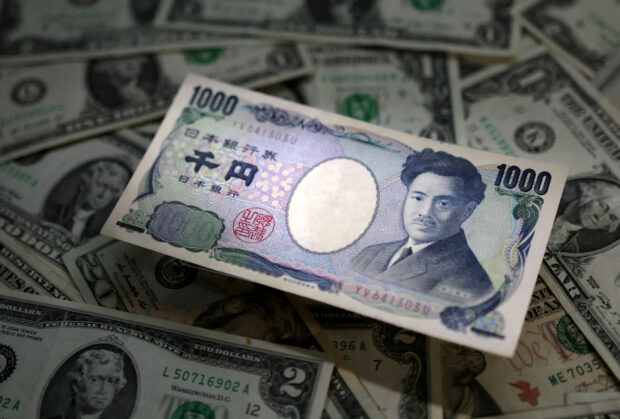Yen eases as BOJ stands pat; China market rescue talk lifts yuan

Japanese Yen and U.S. dollar banknotes are seen in this illustration taken March 10, 2023. REUTERS/Dado Ruvic/Illustration/File Photo
SINGAPORE -The yen fell broadly on Tuesday after the Bank of Japan (BOJ) maintained its ultra-easy monetary settings at the conclusion of its two-day policy meeting, matching market expectations.
The Japanese currency slid roughly 0.3 percent in the wake of the BOJ’s decision to leave unchanged its short-term rate target at -0.1 percent and that for the 10-year bond yield around 0 percent, though it later pared some of those losses.
It was last higher on the day, up 0.1 percent to 147.92 per dollar.
In a quarterly report on the outlook, the BOJ cut its core consumer inflation forecast for the fiscal year beginning in April to 2.4 percent from 2.8 percent projected in October. It slightly revised up its forecast for fiscal 2025 to 1.8 percent from 1.7 percent.
READ: BOJ keeps ultra-easy policy, signals conviction on hitting price goal
Against the euro, the yen edged 0.08 percent lower to 161.32. Sterling rose 0.2 percent to 188.28 yen, not far from a high of 188.91 yen hit on Friday, its strongest level since August 2015.
“With the confirmation of the continuation of monetary easing, (dollar/yen) may test 150,” said Hirofumi Suzuki, chief FX strategist at SMBC in Tokyo, citing the stark interest rate differentials between Japan and the United States.
“In the near term, we should pay close attention to Ueda’s stance at his press conference on monetary policy revisions in the early spring,” he said, referring to BOJ Governor Kazuo Ueda, who was due to speak at 0630 GMT.
Exit from negative interest rate policy
Expectations that the BOJ could phase out its negative interest rate policy this month had been quashed in the wake of the country’s devastating New Year’s Day earthquake and dovish comments by Ueda.
“Most analysts now predict the BOJ will exit its negative interest rate policy at the April meeting after the Shunto wage negotiation result becomes available,” said Joy Yang, head of Asian economic research at Point72.
“While we still see April as the most likely window, the risk that the BOJ will do the first hike later than April has been rising.”
READ: ECB seen in no rush to cut interest rates
The European Central Bank (ECB) also meets this week, where expectations are similarly for its deposit rate to be held steady at the current 4 percent.
ECB policymakers, including President Christine Lagarde, have pushed back against market expectations for early rate cuts.
That’s helped the euro a little, with the single currency having traded largely sideways over the past few sessions. It was last 0.2 percent higher at $1.09055.
China aid
A report that China is weighing a rescue package for its plunging stock markets helped the yuan and the Australian dollar, which is often viewed as a more liquid proxy for exposure to China.
Chinese authorities are considering a package of measures to stabilize the stock market, Bloomberg News reported on Tuesday, citing people familiar with the matter.
READ: China pushes equity fund launches to support stock market -sources
The offshore yuan was last 0.3 percent higher at 7.1700 per dollar. Its onshore counterpart similarly rose 0.3 percent to 7.1714 per dollar.
Down Under, the Aussie rose more than 0.5 percent to $0.6607.
The New Zealand dollar gained 0.47 percent to $0.6106, after having fallen to a two-month low of $0.60625 earlier in the session.
“The (China) news has triggered risk proxies, including the Australian dollar, New Zealand dollar … higher,” said Christopher Wong, currency strategist at OCBC.
“It remains to be seen if this is just talk but if it does materialize sooner than later, then risk proxies can trade higher.”
Broader market
In the broader market, the dollar edged lower, sending sterling up 0.2 percent to $1.2737.
The dollar index fell 0.25 percent to 103.11, though remained not too far from an over one-month high of 103.69 hit last week, as traders pare back their expectations for a rate cut by the Federal Reserve in March.
That’s kept U.S. Treasury yields supported, with the two-year yield last at 4.3784 percent. The benchmark 10-year yield likewise settled above 4 percent and was last at 4.0917 percent.
“We look for the FOMC to remain in a holding pattern, not only with the Fed funds rate at its January meeting, but also with its policy guidance,” said economists at Wells Fargo ahead of next week’s Fed meeting.
“While progress in lowering inflation over the past six months has built the case that rate cuts are coming, the economy’s recent performance suggests no imminent need to ease.”
In cryptocurrencies, bitcoin rose 0.6 percent to $40,048, after slipping below the $40,000 level in the previous session for the first time since the launch of 11 spot bitcoin exchange-traded funds on Jan. 11.